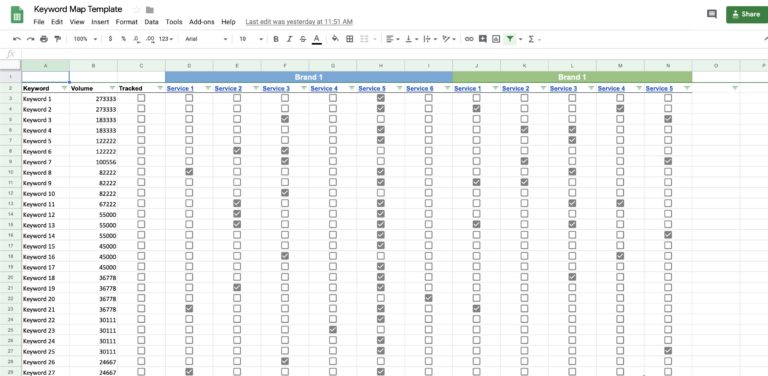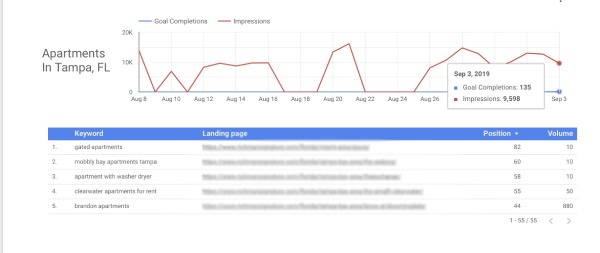08 Sep How to Integrate Keyword Mapping into Data Studio via @seocounseling
Keyword mapping is what separates the pros from the beginners. When we learn how to do keyword research, we start with simple keyword lists that may look something like this:
- Keyword 1 – volume
- Keyword 2 – volume
- Keyword 3 – volume
The reality is that this may actually be fine for small sites with a single service business.
However, enterprise organizations with multiple brands and multiple service per brand require a more complex solution.
What Is Keyword Mapping?
Keyword mapping is a SEO planning technique that involves researching keywords on a page by page basis.
This means that you have individual lists of keywords for each service or specific pages on your site.
If you’re managing the SEO for a company with multiple brands, this makes your keyword map even more expansive.
You will need to account for multiple service areas for multiple brand names.
Why Is Keyword Mapping Helpful?
Keyword mapping allows you to visualize performance in a more siloed view.
This makes it easier to identify your weak points in your keyword targeting strategy.
If you’re managing multiple service lines, then visibility trends for a mix of keywords is not as helpful as a siloed view.
For example, an online store wouldn’t track sales for all products as their only KPI. They break down their sales volume by categories and subcategories.
Why shouldn’t your keyword strategy follow the same principle?
How to Create a Successful Keyword Map
A great way to start your keyword mapping process is to identify the main categories that you need to track.
Start by asking the following questions.
- Do I need to track multiple brands?
- Do these brands offer the same products or services?
- Does it make sense to separate these by geographic region?
Next, identify what your parent category will be. This can be a:
- Specific brand.
- Geographic area.
- General product or service category.
Next, list out your subcategories and any necessary tertiary categories, if relevant.
This is where you will dive into your individual content silos.
Now it’s time to set up your map!
I prefer to use Google Sheets, because it’s easy to share across my SEO agency and with my clients. You can use Excel or any other spreadsheet software that you prefer.
Below is an example of a keyword map template I created for reference.
Important Notes on My Keyword Map Template
Keep All Keywords in One Column
One of the most important things to note here is that I keep all keywords in one column and use checkboxes to notate which category it’s assigned to.
I do this because some categories may share the same keywords.
However, the point of a keyword map is to reduce this as much as possible.
Have a Separate Column to Notate Tracked Keywords
Another helpful addition to my template is that I’ve added a column of checkboxes to notate which keywords you want to track in your preferred keyword tracking software.
You may not want to track every keyword you find, due to the nature of search intent.
However, it’s great to have a wide scope of keywords for each category.
Utilize Tagging for Keywords
In order to fully utilize the Data Studio portion of this tactic, I recommend using a keyword tracking software that allows you to add tags to your keywords. This will be important later in this article.
Use Filters
Apply filters to all the headings of each keyword category. You will be able to filter by True/False values to display only the relevant keywords per category.
This will allow you to narrow your focus per page/category during the planning and execution of your content strategy.


Access the Keyword Map Template
Connecting to Data Studio
Want to take your new keyword map to the next level?
Integrate your keyword tracking software to Data Studio to provide comprehensive insights for your stakeholders.
There are several keyword tracking software companies that are already building data connectors with Data Studio, such as SEMrush.
Third-party companies like Supermetrics are also helping to connect multiple data sources to Data Studio.
Check with your preferred keyword tracking software to see what they offer in terms of Data Studio integration.
Integrate Your Keyword Map
By applying tags or other filters your individual keywords, you can use your mapping functionality to only report on certain categories of keywords.
For example, you can have a single page for a category of keywords or parent brand, with several different data tables for your subcategories of keywords.
All of this can be easily applied by using the filters you’ve set up through your keyword tracking software.
What Else to Track in Data Studio?
You can track whatever your heart desires! Or at least whatever you have room for on your dashboard.
At a bare minimum, I recommend including a line graph for visibility over time and a table for keyword rankings.
However, you don’t have to stop there!
Consider blending data from Google Analytics and Search Console to unlock even deeper insights.
Try blending helpful metrics like organic impressions and organic goal completions with filters to designate performance per category.


Tell a Story with Your Data
There are endless combinations of data points you can display in Data Studio. The key to success is deciding how you will use that data to tell your story.
Many stakeholders may start to fall asleep during your reporting meetings if you get too bogged down in the nitty-gritty metrics.
Try to establish which metrics matter most to them and then integrate the supporting metrics to tell your story.
For example, if you’re creating a top-funnel awareness piece of content, it may rank well, but it may also not drive too many direct conversions.
You can blend data points like visibility, rankings, and organic traffic to lead to assisted conversions in Google Analytics.
The key is to not only control the flow of data, but the flow of narrative.
“Our new content piece improved your rankings, which led to a higher organic visibility. With this higher visibility, we captured top-funnel traffic which can be seen in our increased organic sessions and new user traffic. All of this aligns with a steep increase in assisted conversions tied to our new content piece.”
Conclusion
By integrating your keyword rankings into Data Studio, you can tell stories with your data all in a single chart.
Want to join in the fun?
Try creating your own SEO dashboards and share with the SEO community on Twitter. Make sure to tag @seocounseling and @sejournal in your tweet!
More Resources:
- How to Take Search Console to the Next Level with Google Data Studio
- How to Forecast SEO Potential With Google Data Studio
- Data Visualization: What It Is, Why It’s Important & How to Use It for SEO
Image Credits
All screenshots taken by author, September 2019
Sorry, the comment form is closed at this time.